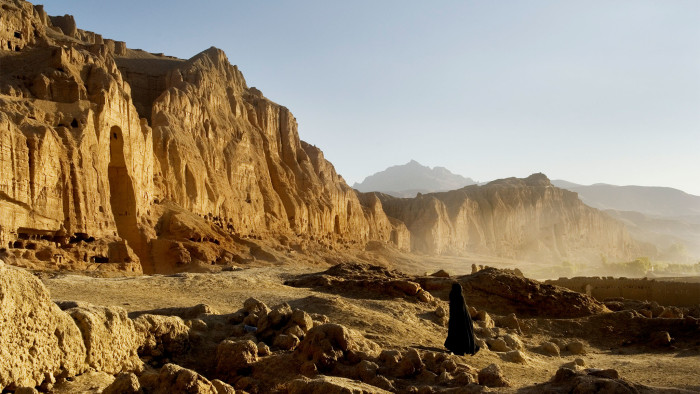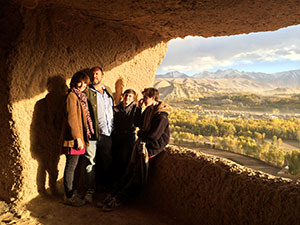A family holiday in Bamiyan valley, Afghanistan

Simply sign up to the Life & Arts myFT Digest -- delivered directly to your inbox.
Of the many places suggested for the possible site of the Garden of Eden, the Bamiyan valley in central Afghanistan might seem, at first, one of the more surprising choices. In 1799 the pioneering, though somewhat eccentric, orientalist Captain Francis Wilford announced to the readers of the journal Asiatic Researches — Shelley among them — that the valley was the real location of the terrestrial paradise. His evidence was the fact that four rivers flowed out of the Bamiyan valley, combined with some spectacularly dubious etymology.
More recently, Bamiyan has been associated with one of the great cultural tragedies of our day: the dynamiting by the Taliban in March 2001 of some of the oldest, and certainly the largest, colossal standing Buddhas ever carved. Yet visiting Bamiyan — particularly as I saw it towards the end of October last year, caught in the embrace of autumn — it is not difficult to understand how Wilford came to his conclusion.
Bamiyan means the Place of Shining Light, and there is something out-of-the-ordinary about the clarity and sharp, high-altitude intensity of the light illuminating this hidden valley, suspended in the midst of the Hindu Kush. As we touched down on the airstrip, the lines of poplars all around us were turning a molten autumnal yellow. Here, even at a distance, the bright slanting morning light picked out with great precision the strangely moving vision of the two vast empty niches in the pale salmon-pink cliffs. They have a real and significant presence, even in the absence of the figures they once contained.
We were surrounded by successive ramparts of camel-coloured foothills, rising through the white-on-black rib cage of the lower ridges to the pure white of the highest snowy peaks: to one side in the distance the black massif of the Koh-i-Baba; on the other, successive precipitous ranges of the Hindu Kush. Yet immediately around us lay one of the greenest and most lovely valleys in the world: a hanging oasis of mulberry and apricot orchards. Fertile fields gave way at the edges of the valley to a rich winter pastureland of borage and clover, dotted with the last of the yellow asphodels and ragged pink hollyhocks. Along the rivulets, semi-nomadic shepherds were leading their great flocks of fat-tailed sheep. White doves took wing among the poplars and umbrella pines. Cut off by geography from most of the troubles of the rest of the country, Bamiyan remains a place of almost otherworldly beauty.
Afghanistan is, in general, getting more and more dangerous, year on year. It is not just the creeping Talibanisation of the rural south that is a cause for concern, so much as the growth of criminality and banditry across the rest of the country. This has put paid to any hope of recovery for a destination that only a decade ago looked set to have a resurgent travellers’ scene after a gap of some 30 years. Yet amid this grim picture of growing insecurity, Bamiyan remains almost completely untouched by violence. The Hazaras who live here suffered doubly from the Taliban, both as ancestral enemies of the Pashtuns and as Shia. Having been virtually enslaved by the last Taliban government, they are now united in allowing the Taliban no foothold in their lands.
Journalist friends in Kabul assured me that Bamiyan was the one place in the country that they all felt safe enough to take their families. So it was that, pressed by my 17-year-old son Sam, who had become obsessed with the idea of Bamiyan, we ended up spending a family half-term holiday in Afghanistan.

Despite the assurances, it still felt a bit of a risk. In the event, it was one of the most successful holidays we have ever had: just enough menace to excite my teenage boys, leavened with enough history and beauty to enchant them. Having returned to school clutching pieces of the bomb that blew up the Buddhas, the younger one, Adam, is now writing an essay on the mujahideen-Soviet war, while Sam is learning Dari on the internet and planning to spend his gap year on some Afghan archaeological site. I’m not sure if this was what we had in mind when we set off for Kabul but, for better or worse, it has certainly stimulated them as much if not more than anything else we’ve ever introduced them to.
…
There are still people in the bazaars of Bamiyan who remember the day the Buddhas were blown up. Initially, the statues were fired at by Taliban anti-aircraft guns and artillery. This caused severe damage but did not destroy them. “This work of destruction is not as simple as people might think,” Qudratullah Jamal, the Taliban information minister, was quoted as saying.
The valley had been almost depopulated by the Taliban, so it took a week to round up enough forced labour to begin the work of laying charges. Some unfortunate Hazaras were suspended on a piece of wood attached by ropes, hanging dangerously from the niche above the Buddhas’ heads, and told to drill in charges every 10 yards. Others had to move a massive cache of munitions — a mixed accumulation of shells, landmines, sticks of dynamite — into position at the base of the statues.
On command, as TV cameras whirred, the charges were blown and, to cries of “Allah hu Akbar! Allah hu Akbar!”, the two statues exploded into a cloud of dust. It was a deliberate challenge to the outside world and the ultimate demonstration of the Taliban’s opposition to idol worship.
…

For a place so distant and isolated today, Bamiyan’s ancient history is astonishingly globalised and cosmopolitan. Alexander the Great passed through on his way to Balkh; the mystic and philosopher Mani, the father of the Manicheans, is believed to have lived and studied here shortly afterwards. But Bamiyan’s golden age was during the period of Buddhist efflorescence between the first and sixth centuries AD.
It was towards the end of that period that the great Buddhas were carved. This was when Afghanistan was the epicentre of classical trade routes: midway from Rome to China, and from the Sogdian trading posts of central Asia to the rich cities of Gupta India. Archaeologists have found painted glass from Antioch, inlaid gold vessels from Ctesiphon, porphyry from Upper Egypt and lapis from Badakhshan, as well as ivories from Kerala, carpets from Persia, and lacquers, paper and silk from Xian and the great cities of Eastern China. It was through this now remote valley that rival ideas of dress and decorum, philosophy and religion, painting and court culture passed backwards and forwards, mixing and melding to create the most unexpectedly syncretic conjunctions.
The slowly-decaying remains of the culture that emerged from this extraordinary fusion of civilisations still litters much of Afghanistan and northern Pakistan. Yet its most magnificent remains are at Bamiyan. At its peak, this valley was one of the largest Hinayana Buddhist monastic centres — it had more than 1,000 caves, compared with 31 at the Indian centre of Ajanta or 500 at the most famous of the Chinese Buddhist cave sites at Dunhuang.
In an age when we are used to prodigiously high structures, the sheer scale of the Buddhas can still take us aback. This was even more so in 1886, when the Illustrated London News sent war artist William Simpson to draw the statues. To give an understanding of their size, Simpson invited his readers to imagine “a general meeting of all the colossal statues of the world”. The Colossi of Luxor would check in at “51ft high, and would be taller if they could stand out of their seats”. Also present at the meeting would be the four statues of Ramses II at Abu Simbel, the bronze Japanese Buddha at Todai-ji, the statue of Athena at the Parthenon and several more. None, wrote Simpson, would barely approach the knees of the larger of the two Buddhas, which originally stood 180ft high.
When the Chinese monk Hiuen Tsiang passed Bamiyan around AD629 he was transfixed by the gilt and jewelled image that flashed from its niche. “Its golden hues sparkle on every side,” he wrote, “and its precious ornaments dazzle the eyes by their brightness.” Like subsequent visitors, he was also taken aback by the quality of light and the beauty of the valley with “springs feeding pools bright as mirrors and . . . trees bright with leaves and blossom.”
No names survive associated with these great prodigies of labour, nor with the extensive outlying complexes of caves and monasteries that extend down the narrower but equally green and beautiful Fuladi and Kakrak valleys. These are guarded by an outer ring of fabulously crumbly Kushan fortifications that look as old as time itself. Here the caves contain more forgotten wall paintings, coffered ceilings, and fragments of broken Buddha figures. Looters and the Taliban have damaged most of these yet tantalising fragments remain in almost all the caves, and you can walk safely for miles, chancing on a great succession of ancient sites that appear in no guidebook.

Buddhism survived until the 10th century in these outlying monasteries, long after Islam had replaced it as the religion of the rulers in Bamiyan itself. In time, Bamiyan became one of the main centres of the Ghaznavid Turkish empire, by which stage stories of Afghanistan’s former wealth had entered folklore. It was partly such rumours that drew the next wave of conquerors, the Mongols, who marched down the valley in 1222. Its defenders put up a strong resistance and killed the grandson of Genghis Khan, which only sealed their fate. When the city was finally captured, the Mongol emperor ordered that every living creature should be killed. Ever since then the citadel has been known as Shahr-e Gholghola, the City of Screams.
Today the former citadel is a wonderfully sinister place, sitting on a skull-like knob of rock and commanding remarkable views over the Bamiyan valley to the peaks beyond. We were shown around by Thomas Lorain, a French archaeologist who has been uncovering a maze of gates, barracks and bazaars.
The future of Bamiyan is now as uncertain as the fate of the rest of Afghanistan. On one hand, the Taliban are advancing and widening their control over much of the rural south; on the other, there is a cautious optimism in Kabul that the capable new president, Ashraf Ghani, can bring peace and turn around the economy.
In the meantime, the wonderful Japanese-owned five-star hotel, built in Bamiyan in happier times, remains open and offers presumably the only teriyaki and maki rolls in the Hindu Kush. A new airport terminal has opened (thanks to Japanese assistance) and there are three flights a week from Kabul: a spectacular 30-minute hop over some of the most precipitous mountains in the world. There are even calls from the locals that the Buddhas should be rebuilt: the fragments of the Buddhas lie catalogued in a warehouse at the base of the cliffs.
Anywhere else this astonishingly beautiful valley, a Unesco world heritage site, would attract tens of thousands of visitors every day. Instead, visitors today more or less have it to themselves, with the occasional company of the odd war correspondent or archaeologist. My advice is: go soon.
William Dalrymple is author of ‘Return of a King: The Battle for Afghanistan 1839-42’ (Bloomsbury)
Photographs: Lana Slezic; William Dalrymple; Corbis
Comments